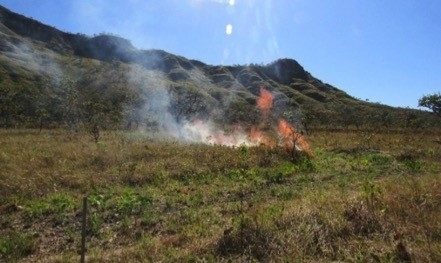

A study led by Brazilian researchers measured species numbers and attributes, as well as carbon dynamics, in two areas of the Brazilian savanna – one is regularly burned and no fires have occurred in the other for 16 years (Cerrado area managed with regular prescribed burning; photo: researchers’ archive)
A study led by Brazilian researchers measured species numbers and attributes, as well as carbon dynamics, in two areas of the Brazilian savanna – one is regularly burned and no fires have occurred in the other for 16 years.
A study led by Brazilian researchers measured species numbers and attributes, as well as carbon dynamics, in two areas of the Brazilian savanna – one is regularly burned and no fires have occurred in the other for 16 years.

A study led by Brazilian researchers measured species numbers and attributes, as well as carbon dynamics, in two areas of the Brazilian savanna – one is regularly burned and no fires have occurred in the other for 16 years (Cerrado area managed with regular prescribed burning; photo: researchers’ archive)
By José Tadeu Arantes | Agência FAPESP – The grasses that grow in tropical savannas evolved some 8 million years ago, in the presence of fire, long before humans emerged on the planet. Fire continues to play a key evolutionary role in this type of biome.
The role of fire in savannas has been the subject of articles published by Agência FAPESP since 2017, and is further elucidated in a new study led by ecologist Alessandra Fidelis, a professor at São Paulo State University’s Institute of Biosciences (IB-UNESP) in Rio Claro (Brazil), and principal investigator for the project “How does the fire season affect the vegetation of the Cerrado?”. An article on the study is published in the journal Science of The Total Environment.
“We found that fire promotes functional diversity owing to plant regeneration strategies after burning. It also contributes to carbon fixation in the soil and subsoil,” Fidelis told Agência FAPESP.
To determine how fire affects the processes that occur in savannas, Fidelis and her collaborators measured various parameters in two different areas of Cerrado (Brazilian savanna), one where fires occur frequently and that had burned recently, and one in which no fires had occurred for 16 years. “We focused specifically on two features of these areas – functional diversity of the vegetation, and carbon dynamics,” she said.
Functional diversity differs from biodiversity in that it encompasses not just species numbers but also the attributes of each species as they relate to its function in a particular environment. The researchers measured both the number of plant species and parameters (height, root diameter and leaf area, among others) that help identify the functions performed by the species in the ecosystem. For example, if the leaf area of a tree or bush expands, more creeping plants can thrive in its shade.
“On this point, it’s important to note that the two areas we studied are in more open parts of the Cerrado, which have lost some of their biodiversity. We call this type of scrubby brushland campo sujo [meaning “dirty meadow” in Portuguese]. The herbaceous stratum is more important than the woody stratum,” Fidelis explained.
Below-ground biomass
With regard to carbon dynamics, the study refutes the widespread belief that fire makes the savanna lose carbon to the atmosphere and contributes to global warming. “In fact, the carbon emitted is rapidly recovered by post-fire plant regrowth. This increases the living biomass and above all the below-ground biomass made up of root networks. Areas that haven’t burned for a long time start to lose below-ground biomass,” Fidelis said.
The researchers measured carbon stocks in both areas, comprising both carbon fixed in biomass and carbon fixed in the soil as a result of leaf, branch, stem and root decomposition. “We measured what was above ground and what was below ground down to a depth of 20 centimeters,” Fidelis said.
It should be borne in mind that tropical savannas and forests are very different ecosystems. A large-scale fire has a disastrous effect on the Amazon Rainforest, leading to biodiversity loss and potentially to collapse throughout the burned area, in addition to its impact on the regional and global climate. In the Cerrado, however, properly managed use of fire is highly desirable, with rotation of burned areas and controlled burning at the right time. “Our study proves that excluding fire leads to carbon losses and a decline in the functional diversity of the soil,” Fidelis stressed.
The article “Fire promotes functional plant diversity and modifies soil carbon dynamics in tropical savanna” is at: www.sciencedirect.com/science/article/abs/pii/S0048969721073939?dgcid=author.
Republish
The Agency FAPESP licenses news via Creative Commons (CC-BY-NC-ND) so that they can be republished free of charge and in a simple way by other digital or printed vehicles. Agência FAPESP must be credited as the source of the content being republished and the name of the reporter (if any) must be attributed. Using the HMTL button below allows compliance with these rules, detailed in Digital Republishing Policy FAPESP.





